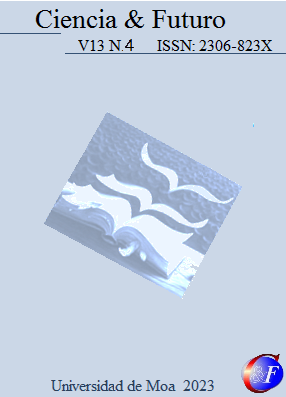Esferas emocionales, cognitivas y sociales del síndrome de lóbulo frontal y prefrontal
Palabras clave:
corteza motora, corteza prefrontal, lóbulos frontales, síndromes frontales, síndromes disejecutivos, trastornos neurológicosResumen
Se realizó una revisión para conocer las principales manifestaciones de los síndromes frontales y prefrontales dependientes del tipo de lesión, sitio, etiología y extensión de la misma. Existen muchas causas potenciales de los síndromes del lóbulo frontal, que incluyen lesiones cerebrales traumáticas, accidentes cerebrovasculares, infecciones, tumores y afecciones degenerativas. Las opciones de tratamiento dependerán de la causa subyacente y pueden incluir medicamentos, terapia conductual y otras formas de rehabilitación.Descargas
Citas
Buxbaum, L. J. & Coslett, H. B. (2009). Apraxia: Sensory System. Encyclopedia of Neuroscience, 553–559. https://doi.org/10.1016/B978-008045046-9.00551-9.
Catani, M. (2019). The anatomy of the human frontal lobe. Handbook of Clinical Neurology, 163, 95–122. https://doi.org/10.1016/B978-0-12-804281-6.00006-9.
Clark, D. L., Boutros, N. N. & Mendez, M. F. (2018). Frontal Lobe. The Brain and Behavior, 73–102. https://doi.org/10.1017/9781108164320.007.
Felten, M. S. & Felten, D. L. (2019). Netter: cuaderno de neurociencia para colorear. Elsevier.
Haque, H., Lobier, M., Palva, J. M. & Palva, S. (2020). Neuronal correlates of full and partial visual conscious perception. Consciousness and Cognition, 78, 102863. https://doi.org/10.1016/J.CONCOG.2019.102863.
Hardwick, R. M., Rottschy, C., Miall, R. C. & Eickhoff, S. B. (2013). A quantitative meta-analysis and review of motor learning in the human brain. NeuroImage, 67, 283–297. https://doi.org/10.1016/J.NEUROIMAGE.2012.11.020.
Heilman K. M. (2021). Upper Limb Apraxia. Continuum (Minneapolis, Minn.), 27(6), 1602–1623. https://doi.org/10.1212/CON.0000000000001014.
Henri-Bhargava, A., Stuss, D. T. & Freedman, M. (2018). Clinical Assessment of Prefrontal Lobe Functions. CONTINUUM Lifelong Learning in Neurology, 24(3, BEHAVIORAL NEUROLOGY AND PSYCHIATRY), 704–726. https://doi.org/10.1212/CON.0000000000000609.
Jones, D. T., & Graff, J. (2021). Executive Dysfunction and the Prefrontal Cortex. Continuum (Minneapolis, Minn.), 27(6), 1586–1601. https://doi.org/10.1212/CON.00000000000001009.
Jumah, F. R. and Dossani, R. H. (2022). Neuroanatomy, Cingulate Cortex. StatPearls. https://www.ncbi.nlm.nih.gov/books/NBK537077/.
Kensinger, E. A. & Ford, J. H. (2021). Guiding the Emotion in Emotional Memories: The Role of the Dorsomedial Prefrontal Cortex. Current Directions in Psychological Science, 30(2), 111–119. https://doi.org/10.1177/0963721421990081/ASSET/IMAGES/LARGE/10.1177_0963721421990081-FIG2.JPEG.
Lau, H. C., Rogers, R. D., Haggard, P. & Passingham, R. E. (2004). Attention to Intention. Science, 303(5661), 1208–1210. https://doi.org/10.1126/SCIENCE.1090973/SUPPL_FILE/LAU.SOM.PDF.
Lázaro, J., Ostrosky, F. & Lozano, A. (2008). Batería de funciones frontales ejecutivas. Presentación. Revista neuropsicología, neuropsiquiatría y neurociencias, 8(1), 141-158. http://revistaneurociencias.com/index.php/RNNN/article/view/233.
Park, J. E. (2017). Apraxia: RevieRehabilitación neuropsicológica en paciente con traumatismo craneoencefálico por daño cerebral sobrevenido. Estudio de casow and Update. Journal of Clinical Neurology (Seoul, Korea), 13(4), 317. https://doi.org/10.3988/JCN.2017.13.4.317
Purdy, M. H. (2022). Aphasia, alexia, and agraphia. Reference Module in Neuroscience and Biobehavioral Psychology. https://doi.org/10.1016/B978-0-323-91497-0.00083-7.
Reber, J. & Tranel, D. (2019). Frontal lobe syndromes. Handbook of clinical neurology, 163, 147–164. https://doi.org/10.1016/B978-0-12-804281-6.00008-2.
Rushworth, M. F. S., Noonan, M. A. P., Boorman, E. D., Walton, M. E. and Behrens, T. E. (2011). Frontal Cortex and Reward-Guided Learning and Decision-Making. Neuron, 70(6), 1054–1069. https://doi.org/10.1016/J.NEURON.2011.05.014.
Salehinejad, M. A., Ghanavati, E., Rashid, M. H. A. and Nitsche, M. A. (2021). Hot and cold executive functions in the brain: A prefrontal-cingular network. Brain and Neuroscience Advances, 5, 239821282110077. https://doi.org/10.1177/23982128211007769.
Sescousse, G., Redouté, J. & Dreher, J. C. (2010). The Architecture of Reward Value Coding in the Human Orbitofrontal Cortex. Journal of Neuroscience, 30(39), 13095–13104. https://doi.org/10.1523/JNEUROSCI.3501-10.2010.
Silva, M. & Ramos, C. (2021). Etiología del daño Cerebral: un aporte neuropsicológico en su construcción teórica (primera parte). Revista Ecuatoriana de Neurología, 30(1), 154-165. https://doi.org/10.46997/revecuatneurol.30100154.
Suzuki, Y. & Tanaka, S. C. (2021). Functions of the ventromedial prefrontal cortex in emotion regulation under stress. Scientific Reports, 11(1). https://doi.org/10.1038/s41598-021-97751-0.
Tiu, J. B. & Carter, A. R. (2022). Agraphia. Encyclopedia of the Neurological Sciences, 86–88. https://doi.org/10.1016/B978-0-12-385157-4.00466-8.
Wang, Y., Du, W., Yang, X., Yan, J., Sun, W., Bai, J., Zhou, J., Zhou, A., Niu, J., Li, C. & Wang, J. (2021). Diagnosis and differential diagnosis flow diagram of Chinese post-stroke aphasia types and treatment of post-stroke aphasia. Aging Medicine, 4(4), 325–336. https://doi.org/10.1002/AGM2.12183.
Publicado
Cómo citar
Número
Sección

Esta obra está bajo una licencia internacional Creative Commons Atribución-NoComercial 4.0.
Esta obra está bajo una Licencia Creative Commons Reconocimiento-NoComercial 4.0 Internacional
La Revista Ciencia & Futuro es una revista de acceso abierto, todo el contenido está disponible gratuitamente sin cargo para el usuario o su institución. Los usuarios pueden leer, descargar, copiar, distribuir, imprimir, buscar o vincular los textos completos de los artículos, o utilizarlos para cualquier otro fin lícito, sin pedir permiso previo al editor o al autor. Todo lo anterior, de acuerdo con la definición de BOAI de acceso abierto.
Los autores que publican en esta revista están de acuerdo con los siguientes términos: Licencia Creative Commons Atribución-NoComercial permite que el beneficiario de la licencia tenga el derecho de copiar, distribuir, exhibir y representar la obra y hacer obras derivadas para fines no comerciales siempre y cuando reconozca y cite la obra de la forma especificada por el autor o el licenciante. Los autores pueden establecer por separado acuerdos adicionales para la distribución no exclusiva de la versión de la obra publicada en la revista (por ejemplo, situarlo en un repositorio institucional o publicarlo en un libro), con un reconocimiento de su publicación inicial en esta revista. Se permite y se anima a los autores a difundir sus trabajos electrónicamente (por ejemplo, en repositorios institucionales o en su propio sitio web) antes y durante el proceso de envío, ya que puede dar lugar a intercambios productivos, así como a una citación más temprana y mayor de los trabajos publicados (Véase The Effect of Open Access) (en inglés). Lo anterior debe realizarse siempre sobre el artículo ya publicado por Ciencia & Futuro.
Los autores mantienen el control sobre la integridad de sus trabajos y el derecho a ser adecuadamente reconocidos y citados.
A los editores se les otorgan derechos no exclusivos para publicar y distribuir.







